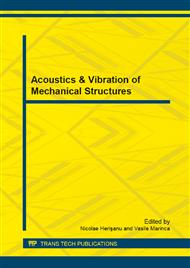[1]
Choudhury A, Tandon N. A theoretical model to predict vibration response of rolling bearings to distributed defects under radial load. Trans ASME, J Vibr Acoust 1998; 120(1): pp.214-220.
DOI: 10.1115/1.2893808
Google Scholar
[2]
Kim PY, Lowe IRG. A review of rolling element bearing health monitoring. In: Proceedings of Machinery Vibration Monitoring and Analysis Meeting, Vibration Institute, Houston, TX, 19-21 April, 1983. pp.145-154.
Google Scholar
[3]
Kim PY. A review of rolling element bearing health monitoring (II): preliminary test results on current technologies. In: Pro-ceedings of Machinery Vibration Monitoring and Analysis Meeting, Vibration Institute, New Orleans, LA, 26-28 June, 1984. pp.127-137.
Google Scholar
[4]
Mathew J, Alfredson RJ. The condition monitoring of rolling element bearings using vibration analysis. Trans ASME, J Vibr, Acoust, Stress Reliab Design 1984; 106: pp.447-453.
DOI: 10.1115/1.3269216
Google Scholar
[5]
McFadden PD, Smith JD. Vibration monitoring of rolling element bearings by the high frequency resonance technique - a review. Tribol Int 1984; 17(1): pp.3-10.
DOI: 10.1016/0301-679x(84)90076-8
Google Scholar
[6]
Meyer LD, Ahlgren FF, Weichbrodt B. An analytic model for ball bearing vibrations to predict vibration response to distrib-uted defects. Trans ASME, J Mech Design 1980; 102: pp.205-210.
DOI: 10.1115/1.3254731
Google Scholar
[7]
Sunnersjo CS. Rolling bearing vibrations Ð geometrical imper-fections and wear. J Sound Vibr 1985; 98(4): pp.455-474.
Google Scholar
[8]
Sunnersjo CS. Varying compliance vibrations of rolling bearings. Journal of Sound and Vibration 1978; 58(3): pp.363-373.
DOI: 10.1016/s0022-460x(78)80044-3
Google Scholar
[9]
Tallian TE, Gustafsson OG. Progress in rolling bearing vibration research and control. ASLE Trans 1965; 8(3): pp.195-207.
Google Scholar
[10]
Tandon N, Nakra BC. Vibration and acoustic monitoring tech-niques for the detection of defects in rolling element bearings - a review. Shock Vibr Digest 1992; 24(3): pp.3-11.
DOI: 10.1177/058310249202400303
Google Scholar
[11]
Wardle FP, Poon SY. Rolling bearing noise - cause and cure. Chartered Mech Engr July/ August 1983: pp.36-40.
Google Scholar
[12]
Zuber N., Automation of rotating machinery failure identification by the means of vibration analysis, PhD Thessis, Faculty of Technical Sciences, University of Novi Sad, (2010).
Google Scholar
[13]
Zuber N, Licen H., Bajric R.,: An innovative approach to the condition monitoring of excavators in open pits mines, Technics technologies education managment, Volume 5, number 1, 2010, pp.3-10, ISSN 1840-1503.
Google Scholar
[14]
Mobius Institute Vibration training manual – category III.
Google Scholar


